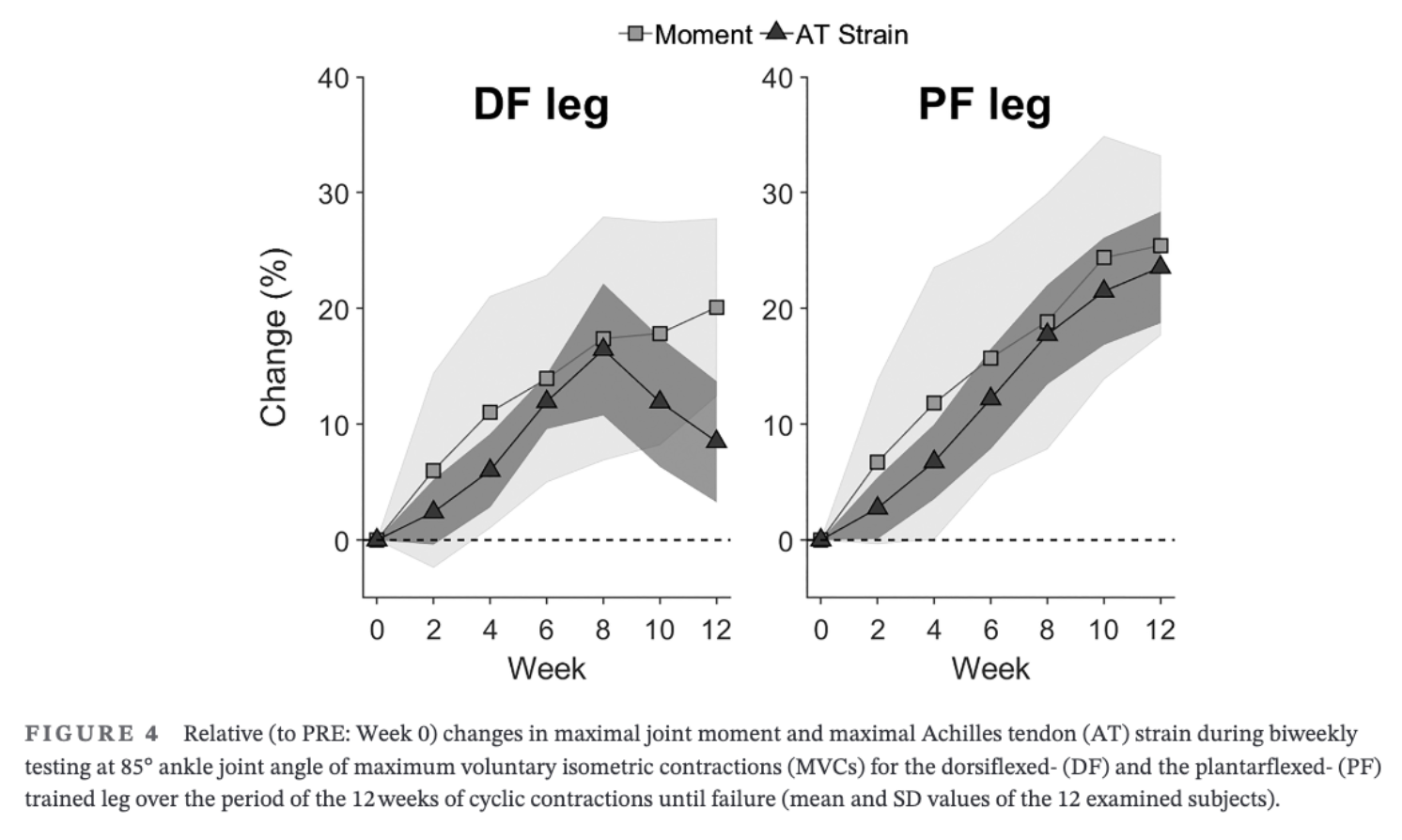Coaches often design programs that focus on muscle, but forget the tendon.
Tendons adapt slower and differently than muscles, which may increase injury risk.
This study explored if muscle and tendon respond differently to similar loading, using a novel training design that varied force and strain without changing effort.
How do muscles vs tendons adapt to metabolic stress and mechanical strain?
Study: Evidence of different sensitivity of muscle and tendon to mechano-metabolic stimuli
What did the researchers do?
Researchers had 12 healthy, active adults (9 male, 3 female) perform 12 weeks of unilateral isometric plantarflexion contractions to failure (3 sets, 3x/week).
Training Methods
- Exercise Type → Isometric (no movement) calf raises pushing against a force plate without moving the ankle.
- Intensity → 80% of their max effort. They tested this every session to keep it accurate.
- Reps → Each set was done until failure (they couldn’t hold the force anymore) with each rep performed with 3 seconds pushing, 3 seconds resting.
- Volume → 3 sets per session, 3 times per week, for 12 weeks.
- Effort & Fatigue → Both legs got equally tired (measured using muscle activity sensors).
- Progression → Loads were adjusted weekly based on strength gains.
- Supervision → Everyone trained under supervision.
Differences in Strain
- DF → One leg trained in dorsiflexion (DF) → long MTU length = high force, high tendon strain (~6%).
- PF → Other leg trained in plantarflexion (PF) → short MTU length = low force, low tendon strain (~2%).
"In each participant, one leg was trained at a short (PF; 115° ankle joint angle; tibiaperpendicular to the shank: 90°) and the other at a long (DF; 85° ankle joint angle) MTU length to achieve low and high levels of muscle mechanical load and tendon strain, respectively."
Measurements
- Muscle architecture (US)
- Tendon stiffness and strain (US + dynamometry)
- Tendon CSA and modulus (MRI)
- Electromyography (EMG)
What were the results?
Muscle
- Strength (+20–25%) and hypertrophy (muscle thickness +8–13%) increased similarly in both legs.
- No difference in EMG or metabolic stress across legs.
Tendon
- Only the DF leg (high strain) increased tendon stiffness (+13%), CSA (+6%), and Young’s modulus (+7%).
- PF leg showed no tendon adaptation despite identical effort.
- Tendon strain increased over time in PF leg, potentially raising injury risk.

What does this mean?
- Muscle hypertrophy and strength can occur without high mechanical loads; metabolic stress and training to failure are sufficient.
- Tendon adaptation, on the other hand, is strain-dependent; tendons need ≥4.5–6.5% strain to trigger remodeling.
- Mismatched muscle-tendon adaptation (stronger muscles with unchanged tendons) can increase mechanical tendon stress and injury risk.
Coach's Takeaway
- Muscle adapts fast to failure-based training, even under low load.
- Tendon only adapts when the strain is high enough, not just when the muscle is tired.
- Plan tendon-specific phases (e.g., heavy slow resistance, isometrics at long lengths) to prevent imbalances and injuries.
This quote is gold from the authors:
"Given that a higher experienced tendon stain can initiate microdamages we argue that if training occurs with low tendon strains (e.g., via muscle fatiguing exercises or low force potential due to the force–length–velocity relationship), tendon adaptations may not keep up with muscle adaptations, which could potentially increase the risk for tendon overuse injuries. Sports and medical practitioners focusing on muscle strength gains need to consider this and should explore whether interventions based on experienced tendon strain rather than the level of muscle demand could help to minimize muscle–tendon imbalances.




